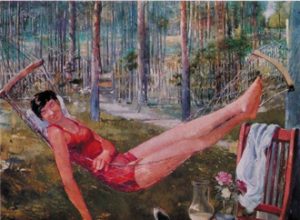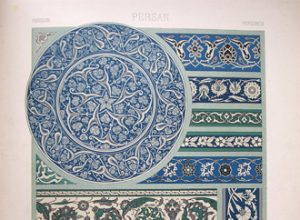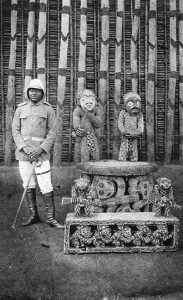
“Race wars are perhaps going to start up again. Within a century, we shall see several million men kill one another other in one fell swoop. The entire East against the entirety of Europe, the Old World against the New! Why not? In another form, great collective projects like the Isthmus of Suez are perhaps rough drafts, preparations for conflicts whose monstrosity we cannot even conceive.”
In his Correspondance, Gustave Flaubert could not avoid the mind-numbing fears of his time, a period that was avid for exoticism as well as keen for political passions caught up in the decline of the West. We now have thinkers, writers, and artists who have unconsciously fashioned the rods by which they are to be punished and, just as much, to punish themselves for a terribly awkward legacy. Obviously, the debate will not end anytime soon about the new Quai Branly Museum or in any other museum. For, we now know that every such site involves an ordering of the world in the name of the worship of art. The sole exception today seems to be those temples of culture where people still do not want to raise the problem of how one’s explicit and implicit world views are expressed in actual fact.
Tzvetan Todorov has told us better than anyone else how crushing and oppressive the history of the discourse on the other has been. “In all times,” he writes, “men have believed that they were better than their neighbors; the only things that have changed are the vices and defects imputed to them.” In his preface, Todorov paid tribute to Edward Saïd’s seminal book on Orientalism because he felt the need to recount, finally, the interlocking fates of power and knowledge.
We now know that Napoleon read the Orientalists before occupying Egypt. Indeed, “one of the most tangible results of this invasion was an immense amount of philological and descriptive work.” Trouble will always come from the discourse on the others. For, he who is the master on the level of speech will be, quite simply, the master of everything. Whether one speaks well or ill of the other, the very act of designating him is a sort of violence.
Through their respective studies, books, and exhibition catalogues, Rémi Labrusse and Benoît de l’Estoile have the merit that comes not only from the richness of their scholarship but also from the newness of their thinking. Both invite us to pose in another way the question of the connections between taste, knowledge, and power. Each one reminds us, after his own fashion, in what way, aesthetic or scientific, knowledge–knowledge of any kind, anywhere and whenever, yesterday, today, or tomorrow–can be organized, instrumentalized, and debased.
Laurence Bertrand Dorléac
Seminar of October 11 2007
The success of the Quai Branly Museum, which is devoted to the “Arts and Civilizations of Africa, America, Asia, and Oceania,” and the upcoming opening of a Department of the Arts of Islam at the Louvre Museum invite questioning about the sense, in today’s world, of placing the “Others” in a museum as well as about the forms such a placement may take.
Appropriations in a Colonial Context
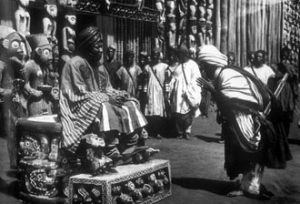
1. Sultan Njoya receiving homage from a vassal. Photo: Marie-Pauline Thorbecke, 1912.
Without going back into the old polemics between those favoring an aesthetic outlook and those advocating ethnographic contextualization, I shall evoke here the modes in which artefacts removed from other continents are appropriated, in all senses of this term. Whether ethnographic in character, devoted to “primitive art,” or concerned with colonial history, the “museums of the Others” have historically been among the main sites for the appropriation of alterity, which they present to the visitor in an ordered fashion in terms of some organizing principle. This kind of appropriation, made possible in large part by a prior dispossession of the first possessors–that is to say, an appropriation involving not only a physical transfer but also a loss of control over the meaning of the artefacts in question–took place within the context of colonialism. I call colonial relation that type of relation established between Europe and the other continents roughly from the fifteenth to the twentieth century. Often marked by violence, it is nevertheless characterized more by appropriation than by the outright negation of the colonized person. By way of contrast, I speak of colonization in the restricted sense of designating political control over a territory by a foreign power for purposes of exploitation; the latter constitutes but one of the possible modes of the colonial relation. Such appropriations happen in a variety of modes–religious, economic, demographic, political, linguistic, artistic, intellectual, etc.–as well as of forms, which vary sharply from place to place and time to time. To a certain extent, it has, despite the asymmetry of the opposing forces, a bidirectional character. [ref]While decolonization marks the end of one mode of colonial relation, it does not mean, ipso facto, the abolition of all the other ones. I refer to my article “L’oubli de l’héritage colonial,” Le Débat, 147 (November-December 2007). [/ref] The appropriation of literally “exotic” artefacts–that is to say, ones from elsewhere–is therefore one of the features of the colonial relation. It happens in a wide variety of modes: artefacts presented as trophies of conquest or exploration, souvenirs of travel to distant places or commodities, supports for narratives of the religious conversion of pagans or of savage civilizations, specimens classified by a kind of anthropology that was the heir of natural history, resources for artistic strategies of rupture within a European academic tradition or elements of local Orientalist color, and so on and so forth. The Colonial Exhibition of 1931 offers a privileged site for observing these diverse modes of appropriation; it was more than what the overly facile image of a “human zoo” might suggest. In order to suggest the ambivalence of these complex forms of appropriation, I employ the expression taste for the Others, which conjures up images of consumption and fascination at the same time.[ref]Le goût des Autres. De l’exposition coloniale aux Arts premiers (Paris: Flammarion, 2007). To avoid any confusion, I underscore that my distinction between “Us” and “the Others refers to social constructions. [/ref] To simplify matters, it can be said that art nègre[ref]Because it today jars our ears, the term art nègre underscores that we are dealing with a dated category, as opposed to other, apparently more neutral ones, like those of Primitive Arts.[/ref]and ethnography constituted, during the interwar period, the two main modes of appropriation of the artefacts of the Others.[ref]I refer in particular to the lectures of Nélia Dias, Sophie Leclercq, and Maureen Murphy in a recent online issue of Arts et Sociétés: http://www.artsetsocietes.org/a/a-index13.html [/ref] In the 1930s, anthropologists appropriated artefacts in the name of an ideal inherited from the natural sciences. The ideal in question, that of drawing up an encyclopedic inventory of the world, seems to have gained the upper hand over appropriation conducted by artists and aesthetes. The triumph of ethnologie (the term was coined in the 1930s by Paul Rivert to refer to the new Science of Man) was expressed in the 1938 inauguration of the Museum of Man, which was both its symbol and its instrument. This mode of appropriation nevertheless became increasingly problematic and subject to challenges both from within (via changes in anthropology) and from without (via competing discourses). Jacques Kerchache, the man who instigated the Quai Branly Museum on behalf of French President Jacques Chirac, used the notion of the Primitive Arts (Arts premiers in French) as a weapon in an effort to delegitimize anthropologists. The creation of the Arts premiers rooms in the Louvre’s Pavillon des Sessions ratified anthropologists’ expropriation, their eviction from the domain of the artefacts of the Others. The Quai Branly Museum offers another configuration, one where anthropology is certainly present yet no longer occupies a leading place. Nevertheless, this rivalry is today in the process of being relativized by new challenges emerging around the issue of reappropriation.
From Appropriation to Reappropriation

2. Paris, 1935. Charles Atangana, paramount chief of the Yaoundé-Bané, and his secretary, Henri Essomba, visiting the Trocadéro ethnology museum’s exhibition of the collections gathered in Cameroon by Henri Labouret. Published in Togo-Cameroun, April-July 1935.
To broach the question of multiple reappropriations, I shall use two photographs. The first was taken in Paris in 1935. Published in the colonial magazine Togo-Cameroun, it shows Charles Atangana, paramount chief of the Yaoundé-Bané, and his secretary, Henri Essomba, visiting Trocadéro’s ethnology museum, where they attended the exhibition of the collections Henri Labouret had gathered in Cameroun the previous year. With both of them wearing garments inspired by uniforms of the Prussian Army, a legacy of the period of German colonization and a sign of their support for the project of establishing an African path to modernity, they are seen standing in front of the throne of Njoya, the Sultan of Bamum.[ref]Togo-Cameroun, April-July 1935. For additional information, see Le goût des Autres, pp. 369-373.[/ref] Another photograph, taken in 1912 by Marie-Pauline Thorbecke, the wife of a German anthropologist, shows King Njoya seated on his throne, receiving homage from a vassal. This throne was one of the insignia of Bamum sovereignty.[ref]Aboubakar Njiasse Njoya, “The Mandu Yienu in the Museum für Völkerkunde, Berlin,” Baessler-Archiv, 42:1 (1994): 16-24.[/ref]

3. Sultan Njoya standing next to the throne of his father in front of the former Foumban palace. Photo: Friedrich Lutz, May 1906. Scanned from African Crossroads: Intersections between History and Anthropology in Cameroon
Comparison of these two photographs tells us a great deal both about the journey of this throne and about the way in which it is entangled in the history of relations between Europe and Africa. In 1908, Njoya offered the throne of his father to Wilhelm II, who donated it to Berlin’s Museum für Völkerkunde. In exchange, Njoya received a German Imperial Guard uniform. Thus, the appropriation by European museums of artefacts belonging to an African sovereign and the appropriation of icons of modernity and of European power were parallel. To an aesthete of today, such a symmetry may seem pathetic, for he reads as kitsch the very thing that for Atangana and Njoya, who were campaigning for the Cameroun people’s adoption of a European way of life, was a sign of one’s entry into modernity. In 1924, Njoya was deposed by the French. He then created a museum in his Foumban palace, where he exhibited the insignia of royal power. It was his son Seidou who in 1934 offered to the Trocadéro museum the throne of his recently deceased father as a way of putting himself in the good graces of the French authorities. Imperial rivalries did indeed make possession of a Bamum royal throne an issue of prestige among museums.
Finally, the figure of Njoya has today become the object of identity-based reappropriations. Inventor of a Bamum system of writing, Njoya is now admired as a model in the “African diaspora.” For example, the quarterly publication of “young Africans and Africophiles [sic]” of Montreal is called Njoya Magazine, d’une rive à l’autre (Njoya Magazine, From one shore to the other).[ref]http://www.njoyamagazine.com/accueil.html[/ref]
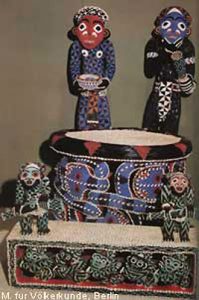
4. Throne of Njoya’s father, Nsangu, Museum für Völkerkunde, Berlin.
The throne of Njoya thus reveals the complexity of phenomena of reappropriation in colonial and postcolonial contexts. One day I would like to organize an exhibition around these themes, based on artefacts like Njoya’s throne(s).
Reappropriation: A New Issue for Museums
The history of these artefacts is therefore made up of multiple transfers and appropriations. And this story is not over. On the contrary, one is led to think that the question of reappropriations will become a key issue for museums over the course of the century now dawning. The past few years have witnessed a multiplication of phenomena involving identity-based reappropriations, and museums are increasingly challenged by the demands of those who proclaim themselves to be the heirs of these artefacts.[ref]L. van Welthem, “Objets de mémoire: Indiens, collections et musées au Brésil,” Arquivos do Centro Cultural Calouste Gulbenkian, 45 (2003): 133-149.[/ref] The perspective afforded by the concept of reappropriation invites museums to take on a new responsibility and to act not only as keepers of “our” national heritage but also of the cultural heritage of the “Others.” Museums can help those groups and individuals who consider themselves to be the heirs of artefacts today kept in museum collections to reappropriate those artefacts, should these groups and individuals so wish; and in particular, museums can favor the establishment of a link with the past through artefacts preserved within their walls. To me, that does not necessarily imply a new expropriation in the sense of a physical transfer of artefacts, “returning” them to the areas whence they came (restitution in the literal sense). The connection people are asking to have with the past need not inevitably be exclusive: what characterizes artefacts in the museums of the Others is the fact that they are tied to a shared history made up at once of violence and appropriation.
Such a perspective invites one to undertake an effort of the imagination. New technological and legal resources open up opportunities on the side of exhibition practices as much as on the side of the conservation and circulation of collections. Anthropologists have a key role to play in this new context inasmuch as their experience in entering into prolonged conversations with the inhabitants of worlds that are different from our own, but that are also in many ways related to ours, places them in a position to play a role go-between.
Bibliography
Bethencourt, F. Ed. Les Arts premiers, Arquivos do Centro Cultural Calouste Gulbenkian, 45 (2003).
Bouquet, Mary and Nuno Porto. Eds. Science, Magic and Religion: The Ritual Processes of Museum Magic. Oxford and New York: Bergahn, 2004.
“Colonial Legacies: The Past in the Present.” Forthcoming section in an issue of Social Anthropology/Anthropologie sociale.
Dias, Nélia. Le Musée d’Ethnographie du Trocadéro (1878-1908). Anthropologie et muséologie en France. Paris: Éditions du CNRS, 1991.
Grewe, Cordula. Die Schau des Fremden: Ausstellungskonzepte zwischen Kunst, Kommerz und Wissenschaft. Stuttgart: Franz Steiner Verlag, 2006.
Le moment du Quai Branly. Special issue of Le Débat, 147 (November-December 2007).
Price, Sally. Paris Primitive: Jacques Chirac’s Museum on the Quai Branly. Chicago: University of Chicago Press, 2007.
Taffin, Dominique. Du musée colonial au musée des cultures du monde. Paris: Maisonneuve et Larose, 2000.
Thomas, Nicholas. Entangled Objects: Exchange, Material Culture, and Colonialism in the Pacific. Cambridge, Mass.: Harvard University Press, 1991.
Thomas, Nicholas. Possessions: Indigenous Art/Colonial Culture. New York and Oxford: Thames and Hudson, 1999.
Benoît de L’Estoile, is an anthropologist who teaches at the École Normale Supérieure. He has just published Le goût des autres. De l’exposition coloniale aux Arts premiers (Paris: Flammarion, 2007). Among other volumes, he has edited Empires, Nations and Natives: Anthropology and State-Making (Durham: Duke University Press, 2005) with Federico Neiburg and Lygia Sigaud. In 2003, he curated “Nous sommes devenus des personnes”: Nouveaux visages du Nordeste Brésilien (“We have become persons”: New faces from the Brazilian Northeast) in Paris (at the École Normale Supérieure) and in Dijon (University of Burgundy). His recently published texts on related topics include “Le Musée de l’Homme, laboratoire de l’ethnologie (1937-2003),” in Les lieux de savoir, ed. Christian Jacob (Paris: Albin Michel, 2007), pp.737-760, “From the Colonial Exhibition to the Museum of Man: An Alternative Genealogy of French Anthropology,” in Social Anthropology/Anthropologie sociale, 11:3 (October 2003): 341-61, and “A Rationalization of Colonial Domination? Anthropology and Native Policy in French-Ruled Africa,” in Empires, Nations and Natives: Anthropology and State-Making (Durham: Duke University Press, 2005), pp. 30-57.
